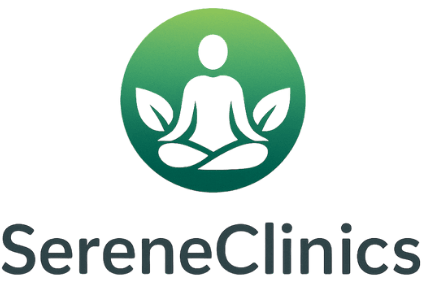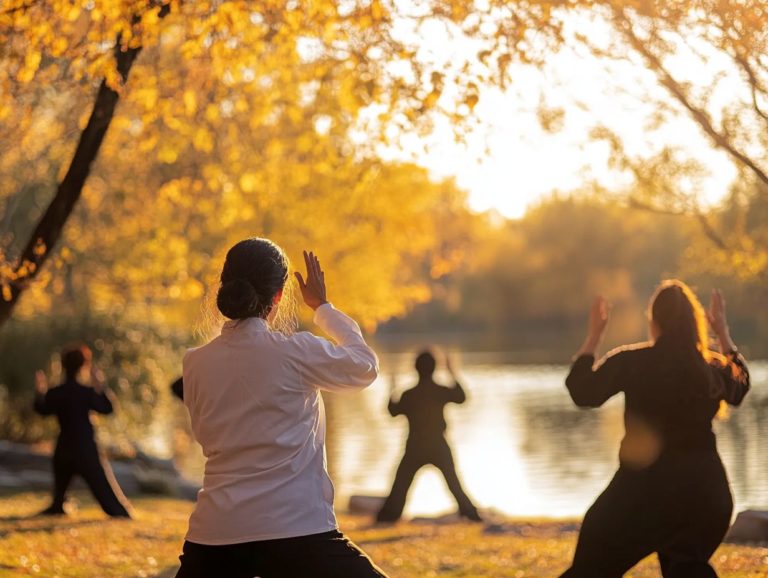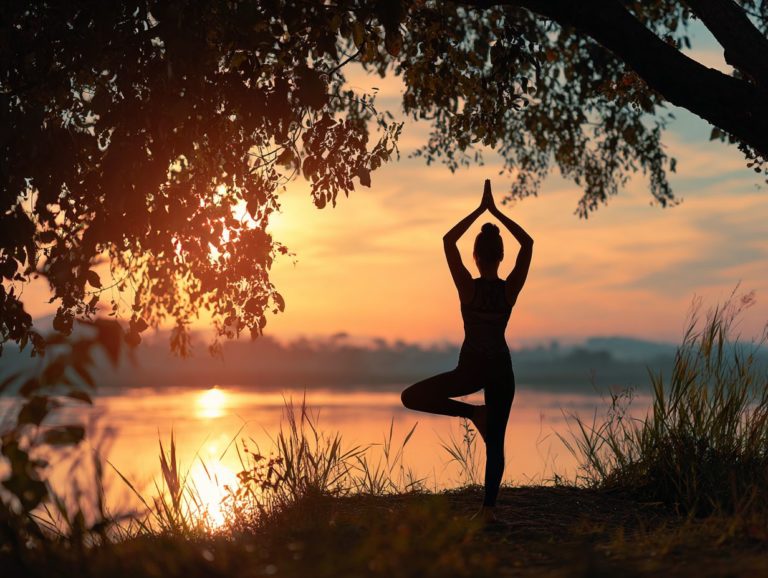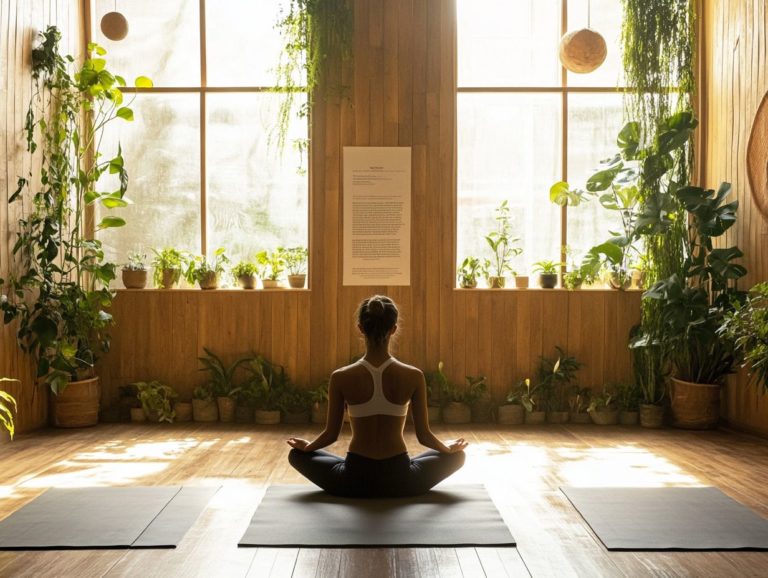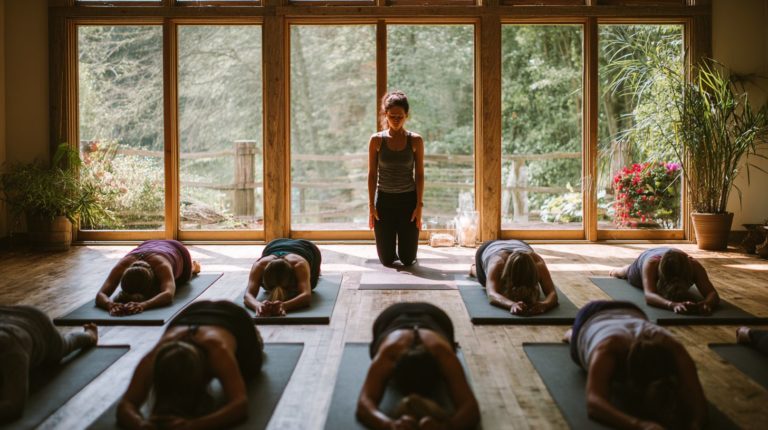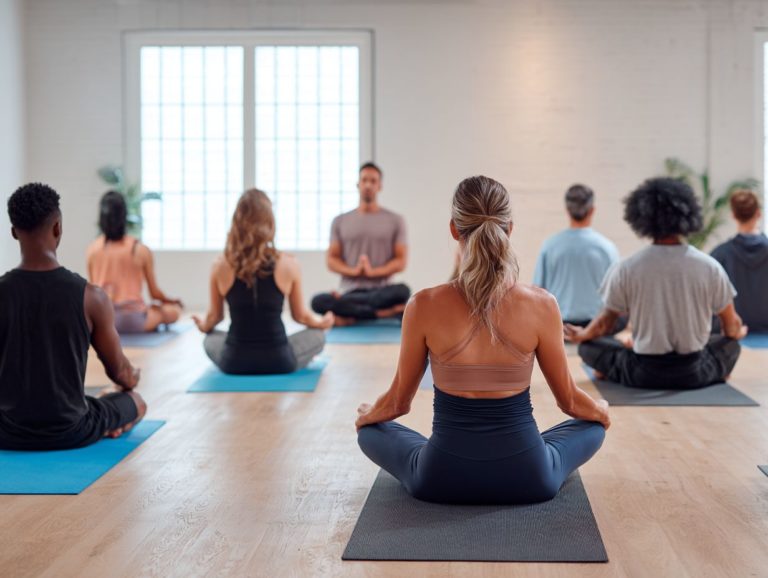Energy Yoga: Practices and Benefits for Health
Experience the benefits of therapeutic yoga with Energy Yoga, a lively mix of practices aimed at achieving the best mind-body health. Based on long-standing practices such as Hatha yoga and the lessons of Patanjali, this method deals with different health issues, improves handling of stress, and improves your regular yoga routine. Learn how Energy Yoga can help improve both your body and mind, giving you a balanced way to live healthier. Find out about its important advantages!
Key Takeaways:
- Energy Yoga is a mind-body practice that combines asanas, pranayama, and meditation to activate the body’s energy flow and chakras.
- The core principles of Energy Yoga include balancing energy, connecting the mind and body, and controlling breath, leading to physical, mental, emotional, and spiritual benefits.
- Doing Energy Yoga often can lower stress and anxiety, build physical strength and flexibility, and improve focus and clear thinking in daily life.
Contents
- 1 Core Principles of Energy Yoga
- 2 Practices in Energy Yoga
- 3 Benefits of Energy Yoga for Health
- 4 Yoga Health Benefits
- 5 Energy Yoga for Specific Conditions
- 6 Integrating Energy Yoga into Daily Life
- 7 Frequently Asked Questions
- 7.1 What is Energy Yoga and how does it benefit health?
- 7.2 What are the main practices of Energy Yoga?
- 7.3 How does Energy Yoga differ from other forms of yoga?
- 7.4 What are the benefits of practicing Energy Yoga?
- 7.5 Is Energy Yoga suitable for everyone?
- 7.6 Can Energy Yoga be practiced at home or is it necessary to attend a class?
Definition of Energy Yoga

Energy Yoga is a healing practice that mixes physical poses, breathing techniques, and meditation to improve the body’s energy flow.
The physical postures, or asanas, focus on aligning the body for optimal energy expression. For example, poses like Downward Dog and Cobra improve flexibility and activate energy pathways.
Complementing this, breath control (pranayama) techniques such as Kapalabhati can invigorate the mind while calming the nervous system. Meditation, often guided, helps to center thoughts and increase mindfulness, resulting in a balanced state. As Healthline highlights, yoga offers numerous science-backed benefits that support mental and physical health.
By combining these components, practitioners can improve general health and increase daily energy levels.
Historical Background
Rooted in the teachings of Patanjali, Energy Yoga has evolved through centuries, integrating Hatha and Iyengar styles to promote flexibility and body awareness.
B.K.S. Iyengar was important in this change, bringing in exact alignment methods that made yoga a healing practice. His 1966 book, ‘Light on Yoga,’ remains a cornerstone text, offering detailed postures and their benefits.
In the late 20th century, figures like John Friend further innovated by incorporating aspects of alignment and flow, leading to the birth of Anusara Yoga. Today, Energy Yoga combines these elements, focusing on breathing exercises and mindfulness, making it accessible to all, whether you’re a beginner or experienced. For those interested in a comprehensive overview of the origins of yoga, Google Arts & Culture offers a fascinating look into the ancient roots of yoga. Additionally, understanding the holistic health benefits of yoga can further enhance your practice.
Core Principles of Energy Yoga
The main ideas of Energy Yoga focus on using energy through chakras, creating a strong mind-body link, and using breathing methods. If you’re interested in expanding your practice, you might explore the different types and requirements of yoga certifications available.
Energy Flow and Chakras
The movement of energy, controlled by the seven chakras, plays a key role in Energy Yoga, affecting both physical wellness and emotional stability.
Chakras, located from the base of the spine to the crown of the head, correspond to different physical and emotional aspects. For example, the root chakra at the bottom of the spine is about feeling secure and grounded, while the heart chakra in the chest promotes love and kindness.
To balance these energy centers, do the warrior pose for the root chakra to build a strong base, and try poses like camel or bridge for the heart chakra. Practicing meditation with affirmations for each chakra can improve your spiritual health. For expanded context, Healthline offers a comprehensive guide to understanding the seven chakras and their meanings.
Mind-Body Connection
Energy Yoga focuses on the link between mind and body, helping people become more aware, which strengthens emotional balance and improves mental well-being.
To build this connection, practitioners can practice mindful breathing methods, such as breathing deeply using the diaphragm, which helps calm the body and lessen anxiety.
Practicing body awareness exercises like progressive muscle relaxation helps people pay attention to their physical feelings, promoting a better grasp of their emotions.
Doing yoga poses regularly, like vinyasa flows that connect breathing with movement, improves awareness. By using these methods, people can handle stress more effectively and improve their ability to deal with emotions, leading to a stable connection between mind and body.
Breath Control Techniques
Breath control techniques, or pranayama, are essential in Energy Yoga, facilitating relaxation and improving cardiovascular function.
Ujjayi, or “victorious breath,” involves constricting the throat slightly while inhaling deeply through the nose, creating a soothing sound. This method helps you feel calm and focused, improving your practice.
Another technique, Nadi Shodhana, or alternate nostril breathing, balances the body’s energy. To perform it, close the right nostril with your thumb, inhale through the left, close it, release the right nostril, and exhale through it. Repeat for several cycles.
Both methods increase lung capacity and reduce stress, making them very helpful in Energy Yoga.
Practices in Energy Yoga
Energy Yoga involves various exercises, including physical movements to increase energy, breathing methods to manage breath, and meditation to clear the mind. Many practitioners are interested in the holistic health benefits that yoga offers. Discover the wide-ranging physical, mental, and spiritual advantages that come from incorporating yoga into your wellness routine.
Asanas for Energy Activation
Specific asanas like Sun Salutations and Warrior poses are particularly effective for energy activation, enhancing flexibility and strength.
Plus Sun Salutations and Warrior poses, consider incorporating these key asanas into your practice:
- Tree Pose (Vrksasana): Improves balance and focus, grounding your energy.
- Camel Pose (Ustrasana): Opens the chest and refreshes the entire body.
- Bridge Pose (Setu Bandhasana): Stimulates the thyroid and improves blood circulation.
- Cobra Pose (Bhujangasana): Strengthens the spine while energizing tired muscles.
For beginners, start with a modified version of each pose, ensuring proper form to maximize benefits without strain.
Pranayama Techniques

Pranayama techniques such as Kapalabhati and Anulom Vilom are powerful tools in Energy Yoga, promoting energy flow and mental clarity.
To include pranayama in your daily routine, start with Kapalabhati, a fast breathing technique that refreshes and increases energy. Begin with 30 seconds of forceful exhalations followed by passive inhalations, gradually increasing duration as you progress.
Next, practice Anulom Vilom, a calming alternate nostril breathing exercise. Begin with a count of four for each inhale and exhale, aiming for five cycles daily.
Both techniques can be practiced in the morning to set a positive tone for the day, contributing to reduced stress and improved focus.
Meditation Practices
Practices in Energy Yoga, such as guided visualizations and focusing on breathing, help develop strong mindfulness and a relaxing state.
These methods help relax the mind and improve emotional strength. For example, guided visualizations involve mentally visiting peaceful places, which can greatly lower anxiety levels.
Alternatively, breath awareness focuses on deep, rhythmic breathing to center scattered thoughts, helping practitioners attain clarity.
To start, dedicate five minutes a day to either practice, progressively extending to 20 minutes as comfort grows. Using apps like Headspace or Calm can offer organized sessions and individualized feedback on your progress, helping you build a lasting meditation routine.
Sound Healing in Energy Yoga
Sound healing, through the use of instruments like singing bowls and tuning forks, complements Energy Yoga by promoting energy balance and relaxation.
Adding sound healing to Energy Yoga classes can improve both physical and spiritual health.
Start by using singing bowls, lightly tapping them to produce calming sounds that help participants relax during long stretches. You can use tuning forks to focus on specific energy areas. For example, a fork vibrating at 432 Hz can be placed near the chest area to help release emotions.
Consider guided meditations accompanied by soft chimes to deepen relaxation and mindfulness. This combination of methods improves the yoga session and encourages a strong sense of inner peace.
Benefits of Energy Yoga for Health
Energy Yoga greatly improves health, providing advantages such as better physical fitness and stronger emotional health. For a deeper understanding of how yoga contributes to holistic health, including physical, mental, and spiritual benefits, explore our insights on Holistic Health Benefits of Yoga.
Yoga Health Benefits
Yoga Health Benefits
Yoga Benefits Stats: Physical Health Benefits
Yoga Benefits Stats: Mental Health Benefits
Yoga Benefits Stats: Lifestyle and Well-being
The data on Yoga Health Benefits Highlights the meaningful benefits of yoga for physical health, mental balance, and daily living. Yoga, a practice with roots in ancient tradition, is increasingly recognized for its broad range of health benefits.
Physical Health Benefits are notable, especially for older adults. Yoga improves flexibility in 65% of adults aged 65+, which is important for keeping you moving and lowering the chances of getting hurt. Furthermore, yoga’s contribution to improved cardiovascular function is backed by over 1400 studies, showing how it benefits heart health by lowering stress and improving blood flow.
Mental Health Benefits show yoga’s effectiveness in relieving stress for 80% of US adults, highlighting its role as a powerful tool for managing daily stressors. Yoga also helps in managing depression, with the World Health Organization (WHO) noting a 5% improvement in symptoms, emphasizing yoga’s potential as a complementary therapy for mental health challenges.
Regarding Lifestyle and Well-being Yoga greatly improves life for people with ongoing pain, backed by a 2019 study. This benefit helps improve sleep quality and encourages a positive body image and self-esteem, as evidenced by studies conducted in 2019 and 2020. Also, yoga helps lower burnout among hospice workers, supported by a 2021 study, indicating its restorative power in high-stress professions.
Overall, the Yoga Health Benefits Data shows yoga’s many benefits, including better physical health, stronger mental resilience, and improved lifestyle. As more people learn about these benefits, yoga continues to provide a complete method for overall health and wellness.
Physical Health Benefits

Practicing Energy Yoga regularly can lead to significant improvements in flexibility, muscle strength, and pain management.
Studies indicate that practitioners experience a 40% reduction in chronic pain over three months, highlighting its effectiveness. For instance, a 2017 survey by the American Yoga Alliance found that 78% of participants reported reduced back pain after integrating Energy Yoga into their routine.
To increase flexibility, concentrate on exercises like the Cat-Cow Stretch or Downward Dog, which stretch and build important muscle groups. Doing this exercise three times a week can improve your physical health over time and is a useful method for managing pain.
Mental Health Benefits
Energy Yoga supports mental health by decreasing anxiety and encouraging emotional balance through focused exercises and controlled breathing.
Research shows that Energy Yoga can significantly decrease anxiety levels. A study published in the Journal of Alternative and Complementary Medicine found that participants practicing Energy Yoga showed a 40% reduction in anxiety after eight weeks.
Practitioners often say they feel better and can handle their emotions more effectively. Techniques such as slow breathing and imagining peaceful scenes helps in increasing concentration and focus, making them helpful for managing stress.
Adding a weekly session or a daily habit can lead to lasting benefits for emotional well-being, as shown by many stories from people who have adopted this complete method.
Emotional Well-being
Energy Yoga strengthens emotional well-being by improving coping skills and stress management, which are important for today’s lifestyle.
Practicing Energy Yoga includes techniques like controlled breathing, focused physical activity, and meditation. These methods help build strength. For instance, incorporating deep abdominal breathing can help calm the nervous system and reduce anxiety on the spot.
Doing sun salutations regularly helps improve physical strength and creates a routine that improves mental focus. Mindfulness meditation, practiced for just 10 minutes daily, can significantly improve focus and emotional regulation.
Including these habits in your daily routine can significantly help you stay emotionally steady and better handle stress.
Spiritual Growth
Energy Yoga supports spiritual development by encouraging self-confidence and awareness, enhancing the practitioner’s experience.
By practicing breath control and meditation, individuals can greatly improve their awareness of themselves. For example, dedicating 10 minutes daily to conscious breathing can help clarify thoughts and emotions.
Using affirmations during yoga sessions can strengthen a positive self-image and goals, supporting personal growth. Tools like guided meditation apps provide structured support to keep practitioners engaged and focused.
People who regularly practice often feel more in touch with themselves, leading to significant personal change.
Energy Yoga for Specific Conditions
Energy Yoga provides specific advantages for different health issues, such as reducing stress, handling long-term pain, and improving concentration. To explore techniques similar to Energy Yoga, our expert opinion on Qigong techniques and benefits offers an insightful perspective on how these practices contribute to overall health.
Stress Relief and Anxiety Management
Studies demonstrate that Energy Yoga can greatly lower stress and help alleviate anxiety, making it an effective treatment.
Energy Yoga uses particular methods that improve mental focus and emotional strength. Exercises like deep breathing and gentle movements, such as Child’s Pose and Cat-Cow, help you focus your mind and relax.
Incorporating visualization techniques during sessions can help redirect negative thoughts. Regularly practicing Energy Yoga for 20-30 minutes a few times a week allows individuals to establish a calming routine, leading to improved mental health over time.
Many practitioners also find that integrating meditation at the end of each session deepens the stress-relieving benefits.
Improving Flexibility and Strength
Doing Energy Yoga regularly can make you more flexible by up to 30% and greatly strengthen your muscles, especially in the core and lower body.
To experience these benefits, include specific yoga poses like Downward Dog, Warrior II, and Pigeon Pose in your routine.
For example, Downward Dog stretches the hamstrings and strengthens the shoulders and core. A study indicates that practitioners who committed to a biweekly Energy Yoga class reported improved flexibility and reduced muscle tension within just a month.
Coupling these asanas with breath control techniques, like Ujjayi breathing, can deepen your practice, enhancing both physical and mental resilience.
Enhancing Focus and Clarity
Activities in Energy Yoga, like meditation and breathing exercises, improve concentration and clear thinking, which are important for daily tasks.
To integrate these practices into your routine, start with a simple morning meditation for 10 minutes. Tools like Headspace or Calm offer guided sessions catering to various focus needs.
Try breathing exercises like the 4-7-8 technique: breathe in for 4 seconds, hold your breath for 7 seconds, and breathe out for 8 seconds. This can lower stress and improve your focus before starting your daily activities.
Think about enrolling in online classes or workshops to learn more and stay motivated with support from others.
Integrating Energy Yoga into Daily Life
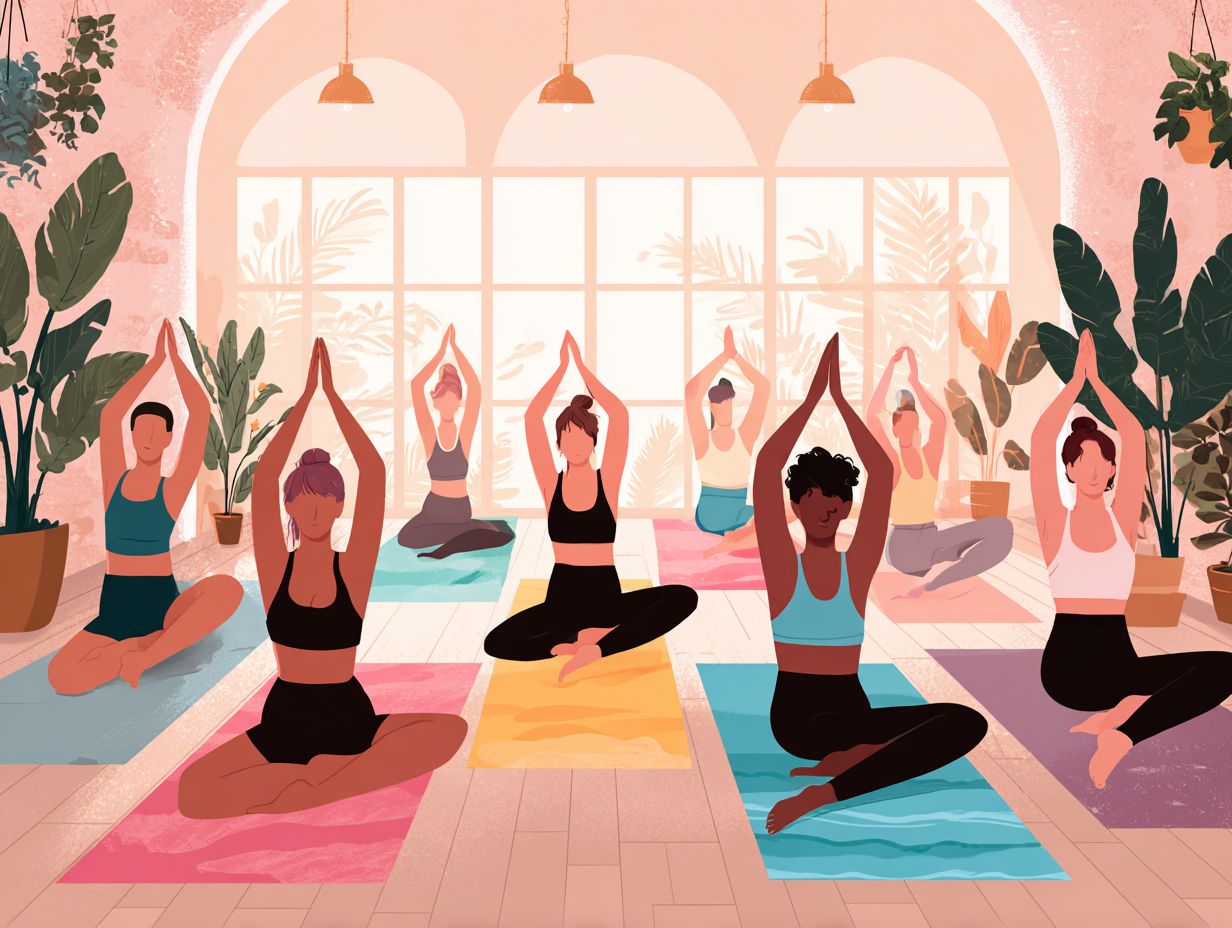
Adding Energy Yoga to your daily routine requires commitment and can be achieved through personal practice and joining community events.
Creating a Personal Practice
Doing Energy Yoga regularly can help you feel more in control and aware, helping you connect better with yourself.
To create an effective Energy Yoga routine, start with a duration of 20-30 minutes, focusing on a blend of breathwork and gentle movements.
Aim for 3-4 sessions weekly to establish consistency. Use resources like the ‘Energy Yoga’ app for guided sessions, or watch YouTube channels that have Energy Yoga routines.
Begin each session with intention-setting and end with mindfulness meditation to consolidate your practice.
Write in a journal to keep track of your progress and think about your experiences. This helps you learn more about how you are growing personally.
Community and Group Practices
Joining community and group sessions of Energy Yoga strengthens social bonds and helps maintain regular practice.
To find local classes, check platforms like Meetup or Facebook Events for listings in your area.
Local yoga studios often offer group classes that encourage a collaborative environment. For those preferring online options, platforms such as Zoom or Mindbody provide virtual group sessions.
Being part of a committed group can help you stay responsible; think about signing up for weekly classes with friends or family. Joining a community helps you get better in your practice while exposing you to different methods and viewpoints that make your experience more fulfilling.
Frequently Asked Questions
What is Energy Yoga and how does it benefit health?
Energy Yoga is a form of yoga that helps use the body’s energy to improve physical health, clear thinking, and emotional well-being. It combines traditional yoga postures and breathing techniques with energy work to promote overall health and balance.
What are the main practices of Energy Yoga?
The main practices of Energy Yoga include asanas (physical postures), pranayama (breathing techniques), mudras (hand gestures), and bandhas (energy locks). It also includes meditation and visualization techniques to improve the movement of energy in the body.
How does Energy Yoga differ from other forms of yoga?
While traditional yoga focuses on physical and mental well-being, Energy Yoga specifically targets the body’s energy flow. It also uses specific energy points and pathways in the body, along with visualizations and meditation, to improve the benefits of the practice.
What are the benefits of practicing Energy Yoga?
Regular practice of Energy Yoga can lead to a stronger and more flexible body, improved mental clarity and focus, increased energy levels, and a more positive outlook on life. It also helps lower stress and anxiety, improve sleep quality, and improve overall health.
Is Energy Yoga suitable for everyone?
Energy Yoga is suitable for people of all ages and fitness levels. People who have health issues or injuries should talk to a doctor before beginning this activity. It is also important to always listen to your body and modify postures as needed.
Can Energy Yoga be practiced at home or is it necessary to attend a class?
While attending a class with a certified instructor can be beneficial for beginners, Energy Yoga can also be practiced at home. There are many resources available, such as online classes and instructional videos, for those who prefer to practice on their own. However, it’s important to know the basics of the practices and techniques before trying them at home.

Sheetal Sharda has a background in CS. She got an interest in Holistic living back in 2018, and has since started exploring more into Naturapathy, Holistic Living, Yoga, and more. She got inspired to start SereneClinics to help people find reliable centers across the world.
